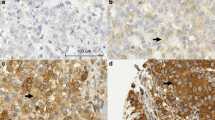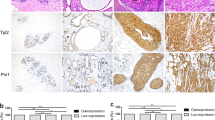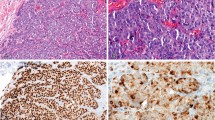Abstract
Glutathione S-transferase Pi (GST P) has been reported to be a marker of dysplastic lesions. For this reason expression of GST P by intraduct breast carcinoma was evaluated by immunohistochemistry. Thirty-seven of 92 carcinomas (40%) were GST P positive. GST P staining did not correlate with histological variables, c-erbB-2 overexpression or with clinical outcome. The GST P status of recurrences did not correlate with that of the index lesion. There is little evidence that GST P is a useful marker of the potential of intraduct breast carcinoma to become invasive.
This is a preview of subscription content, access via your institution
Access options
Subscribe to this journal
Receive 24 print issues and online access
$259.00 per year
only $10.79 per issue
Buy this article
- Purchase on Springer Link
- Instant access to full article PDF
Prices may be subject to local taxes which are calculated during checkout
Similar content being viewed by others
Author information
Authors and Affiliations
Rights and permissions
About this article
Cite this article
Bellamy, C., Harrison, D. Evaluation of glutathione S-transferase Pi in non-invasive ductal carcinoma of breast. Br J Cancer 69, 183–185 (1994). https://doi.org/10.1038/bjc.1994.31
Issue Date:
DOI: https://doi.org/10.1038/bjc.1994.31
This article is cited by
-
GSTP1 promoter hypermethylation is an early event in breast carcinogenesis
Virchows Archiv (2007)
-
Association of GSTP1 CpG Islands Hypermethylation with Poor Prognosis in Human Breast Cancers
Breast Cancer Research and Treatment (2006)
-
GlutathioneS-transferase expression in malignant mesothelioma and non-neoplastic mesothelium: an immunohistochemical study
Journal of Cancer Research and Clinical Oncology (1996)



